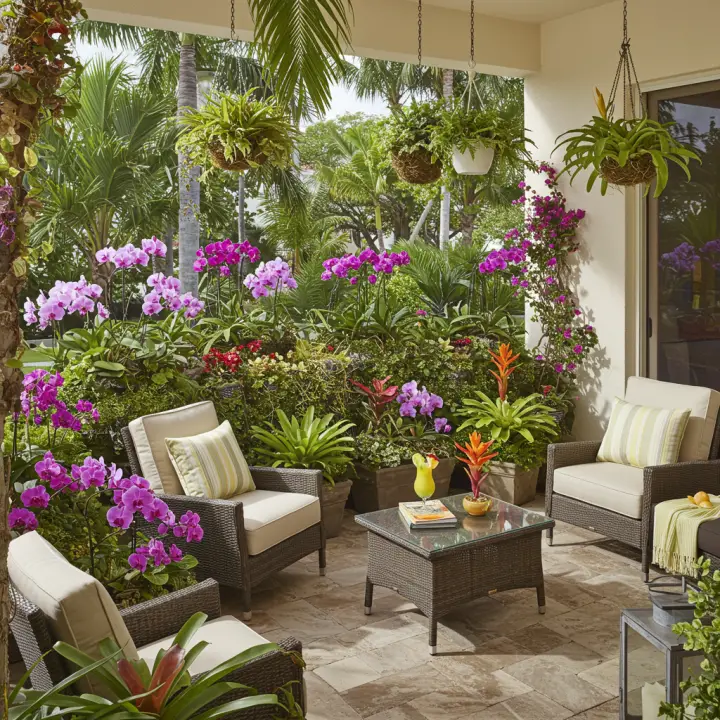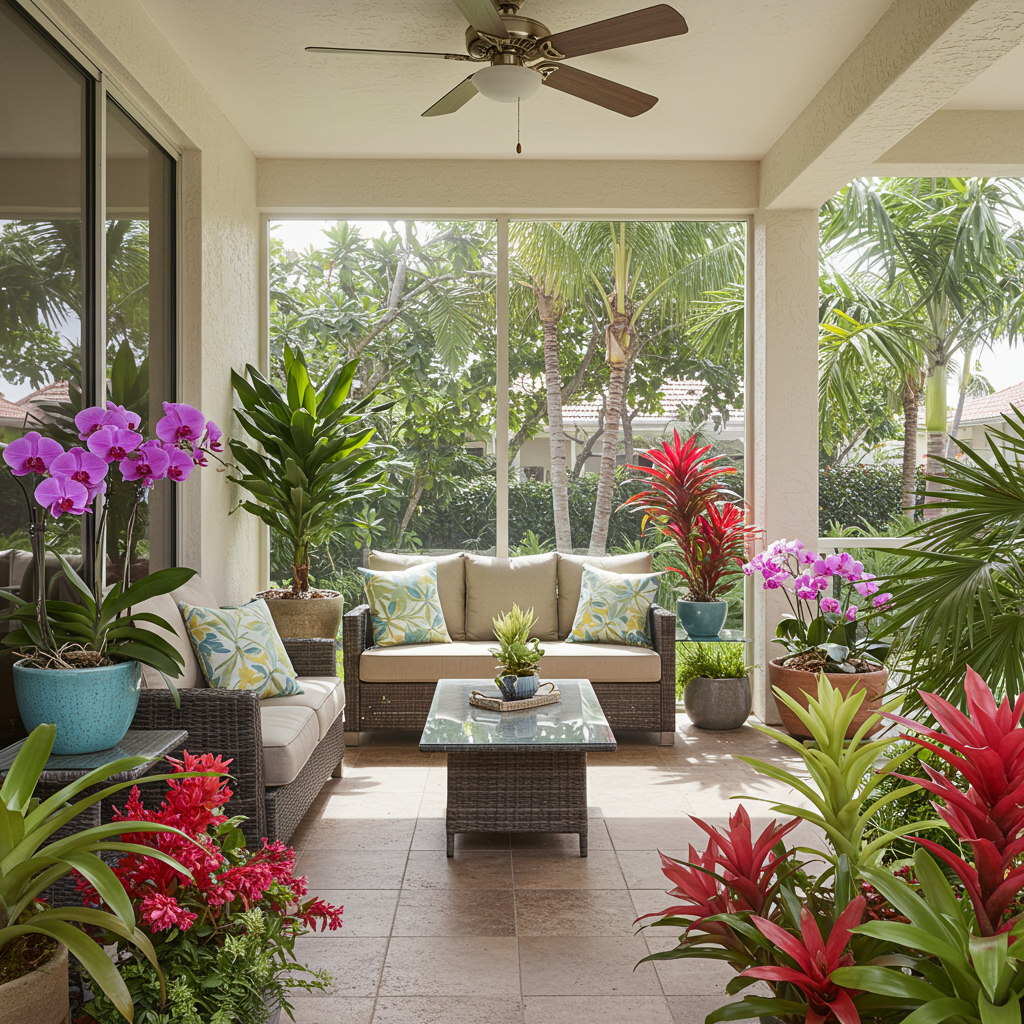Discover the best Lanai plants perfectly suited for South Florida’s climate, from vibrant flowering options to lush foliage, ensuring your outdoor space thrives with beauty and color.
South Florida’s unique climate offers an incredible opportunity to create a lush, tropical paradise right outside your door. For many, this dream space is the lanai – a covered patio area perfect for relaxation, entertaining, and enjoying the balmy weather without direct sun or rain. But what makes a lanai truly come alive? The right plants! Choosing the best lanai plants means understanding both your lanai’s specific conditions and the tropical resilience needed for the region. Let’s explore stunning choices that will transform your outdoor living space into a vibrant oasis.

Why Choose the Right Lanai Plants for South Florida?
When selecting plants for your lanai, understanding the distinct advantages and challenges of this environment is key. A lanai offers protection from intense sun and heavy rainfall, but also slightly different light and humidity levels compared to open garden spaces.
Climate Resilience: South Florida experiences high humidity, heat, and occasional cold snaps. Plants chosen for your lanai must be able to thrive in these conditions, including the filtered light often found under a lanai roof.
Aesthetics and Ambiance: Plants add vital color, texture, and life, turning a simple concrete space into an inviting outdoor room. They enhance the tropical feel, creating a serene and private atmosphere.
* Air Quality Benefits: Many plants are natural air purifiers, helping to filter toxins and improve the air quality around your living space.
Top Flowering Lanai Plants for Vibrant Color
To infuse your lanai with dazzling hues, consider these excellent flowering plant options that love South Florida’s warmth and humidity.
Bougainvillea
While typically a sun-lover, dwarf or potted varieties of Bougainvillea can thrive on a lanai with ample bright, indirect light. Their vibrant, paper-like bracts (often mistaken for flowers) come in shades of pink, purple, red, and orange, creating a spectacular cascading effect over railings or from hanging baskets.
Mandevilla and Dipladenia
These exquisite tropical vines are perfect for trellises or hanging baskets on a lanai. They boast continuous blooms throughout the warmer months, with trumpet-shaped flowers in striking reds, pinks, and whites. They appreciate the bright, indirect light a lanai provides and tolerate high humidity well.
Orchids (Phalaenopsis & Vanda)
For an exotic touch, orchids are surprisingly great lanai plants. Phalaenopsis (Moth Orchids) thrive in the filtered light and consistent humidity of a lanai. For brighter lanai spots, Vanda orchids offer spectacular, large blooms and are often grown in hanging baskets to allow their roots to dangle freely.
Hibiscus (Dwarf Varieties)
The quintessential tropical flower, dwarf hibiscus varieties or those grown in larger pots can flourish on a lanai. Their large, showy blooms in single or multi-color patterns add an instant exotic flair. Ensure they receive sufficient bright light to encourage abundant flowering.
Pentas
Also known as Egyptian Starcluster, Pentas are butterfly magnets that produce clusters of star-shaped flowers in shades of pink, red, lavender, and white. They offer continuous blooms and are relatively low-maintenance, making them a cheerful addition to any lanai.
Lush Foliage Lanai Plants for Greenery and Texture
Beyond flowers, foliage plants add structure, varying shades of green, and intriguing textures that round out your lanai garden.
Ferns (Boston, Kimberly Queen, Macho)
Ferns are natural choices for humid, shaded environments like a lanai. Varieties like the Boston Fern offer delicate fronds, while Kimberly Queen ferns are more robust and upright. Macho ferns provide a bold, lush statement with their substantial fronds. They all thrive on consistent moisture and appreciation the lanai’s protection from harsh sun.
Calathea and Maranta (Prayer Plant)
Known for their strikingly patterned leaves, Calatheas and Marantas are shade-loving beauties. Their leaves often feature intricate designs in vibrant greens, purples, and reds, adding a dramatic flair. They also have the fascinating habit of folding their leaves up at night, resembling praying hands.
ZZ Plant (Zamioculcas zamiifolia)
For the ultimate low-maintenance option, the ZZ plant is almost indestructible. It tolerates low light, drought, and general neglect, while still providing glossy, dark green foliage that adds a sophisticated touch. Perfect for those who travel or are new to plant care.
Dwarf Areca Palm
Bringing a classic tropical vibe, the dwarf Areca Palm works beautifully in a large pot on a lanai. Its feathery fronds create an elegant, airy presence and it’s also a known air-purifying plant, adding health benefits to its beauty.
Dracaena
With numerous varieties offering different leaf shapes and colors, Dracaenas are versatile lanai plants. From the upright ‘Janet Craig’ to the colorful ‘Lemon Lime’, they are hardy, easy to care for, and excellent at purifying the air.
Edible & Aromatic Lanai Plants
Don’t limit your lanai garden to purely ornamental plants! Incorporate edibles and aromatic herbs for an extra layer of enjoyment.
Fresh Herbs (Basil, Mint, Rosemary, Thyme)
Many herbs thrive in containers on a lanai, especially if they receive a good amount of bright, indirect light. Imagine stepping out to snip fresh basil for dinner or mint for a refreshing drink. Rosemary and thyme also do well and add delightful aromas.
Small Citrus Trees (Calamondin, Meyer Lemon)
Dwarf citrus varieties like Calamondin oranges or Meyer lemons can be grown successfully in large pots on a well-lit lanai. They offer fragrant blossoms, attractive fruit, and a true taste of the tropics.
Dwarf Banana Tree
For a truly bold and tropical statement, a dwarf banana tree can make a dramatic impact on a spacious lanai. While full-sized fruit may be challenging, their large leaves and exotic appearance are well worth the effort.
Essential Tips for Lanai Plant Care in South Florida
To ensure your lanai plants flourish, keep these care tips in mind:
Understanding Light Conditions
Even under a lanai roof, light can vary. Observe which areas get bright indirect light, moderate shade, or shadier conditions throughout the day. Match your plant choices to these specific light levels for optimal health.
Watering Wisdom
Potted plants dry out faster than those in the ground. Check soil moisture regularly (stick your finger about an inch deep). Water thoroughly until it drains from the bottom, then allow the top inch or two to dry out before watering again. High humidity on a lanai can reduce watering frequency slightly, but don’t assume the humidity is enough without checking the soil.
Fertilization
Tropical plants are often heavy feeders. During their growing seasons (typically spring to fall), fertilize regularly with a balanced liquid fertilizer or slow-release granular form, following product instructions.
Pest and Disease Management
High humidity can sometimes encourage fungal issues or pests. Regularly inspect your plants for signs of trouble. Early detection allows for easier treatment with organic solutions like neem oil or insecticidal soap. Ensure good air circulation to prevent fungal problems.
Container Choice and Potting Mix
Always use pots with drainage holes to prevent waterlogging, which can lead to root rot. Choose a high-quality potting mix designed for containers, ensuring good drainage and aeration. Terra cotta pots can help with evaporation, while plastic or glazed pots retain moisture longer.
Frequently Asked Questions (FAQs) About Lanai Plants
Q1: What’s the main difference between growing plants on a lanai versus in full sun?
A1: The primary difference is light intensity and protection. Lanai plants receive filtered or indirect light, protecting them from the harsh midday sun and heavy rainfall. This means you need to choose plants that thrive in these moderate light conditions, often requiring less water than plants in full sun.
Q2: Do lanai plants need special winter protection in South Florida?
A2: It depends on the plant and the severity of the cold snap. While a lanai offers some thermal protection, very sensitive tropicals may still need to be moved closer to the house, covered with frost cloth, or brought indoors if temperatures are forecast to drop below 40°F (4°C) for extended periods.
Q3: How often should I water my lanai plants?
A3: There’s no single answer, as it depends on the plant species, pot size, type of potting mix, and ambient temperature/humidity. A good rule of thumb is to check the soil moisture every few days. Water when the top inch or two of soil feels dry to the touch, and water thoroughly until it drains from the bottom.
Q4: Can I grow vegetables on my lanai?
A4: Yes, some vegetables and herbs can thrive on a lanai, especially those that prefer partial shade or bright indirect light, like leafy greens (lettuce, spinach), herbs (basil, mint, cilantro), and some small peppers or cherry tomatoes if your lanai receives ample bright light.
Q5: Which are the most low-maintenance lanai plants for South Florida?
A5: For minimal fuss, consider ZZ Plants, Snake Plants, Cast Iron Plants, many varieties of Dracaena, and robust ferns like the Kimberly Queen or Macho fern. These are tolerant of varied light conditions and don’t require constant attention.
Conclusion
Transforming your South Florida lanai into a verdant sanctuary is an achievable and rewarding project. By selecting the best lanai plants – a thoughtful mix of vibrant flowering species, lush foliage, and even aromatic edibles – you can create an outdoor living space that is not only beautiful but also perfectly suited to the unique conditions of a lanai. With a little attention to light, water, and general care, your lanai will become a breathtaking extension of your home, inviting you to relax and soak in the tropical splendor.

